
Screen Time in Children
- Brooklin Vision Care
Screen time in children is a topic that comes up quite frequently – How much is too much? What are appropriate apps and games? What amounts are suitable for what ages?
What we didn’t bank on was just HOW much our children’s screen time would increase, due to the Covid-19 pandemic.
The Canadian Pediatric Society recommends no screen time for those under two years old, one hour per day for children two to twelve, and two hours per day for teens. This guideline became virtually impossible during the pandemic with online school, and children were unable to see family and friends unless they video chatted. There just wasn’t much else to do.
Parents- there’s no need to feel guilty for the increased screen time. We were living in a world where there wasn’t much else to do, and you had to do what you needed to in order to stay sane (and work from home if you were doing so, or even just to get things done!) There simply was no other choice at times. However, as we move on from the restrictions, it’s important to set limits and ensure children are getting a good balance of indoor and outdoor time.
There are SO many benefits to outdoor time and creative play. Improved sleep, confidence, a boosted immune system and cognitive development are just a few of the positive things our children will experience if they are taken away from screens. Too much screen time can result in physical strain to the eyes and the body, obesity, anxiety, depression, attention issues and impaired social skills. The other effect it can have is increased myopia in children. Myopia (also called nearsightedness) occurs when our eyes spend more time focusing on near objects (like screens). It makes our eyeballs elongate, which causes distant objects to appear blurred.
Our sleep can be affected by screen use as well. Blue light from devices can affect melatonin levels, which are important in regulating sleep. Minimising screen use before bed can help reduce sleep issues.
WHAT they’re watching matters too- quality, age-appropriate, educational and interactive programs are best. They give children an opportunity to be creative and use their minds.
So, why exactly is an eye care website lecturing you about too much screen time in children? Well, unfortunately, the eyes are probably the most affected part of the body when it comes to excessive screen use.
WHAT CAN YOU DO ABOUT IT?
In addition to decreasing screen time, there are a couple things that you need to remember when in front of the television or a tablet:
- Blink! On average, we blink 12 times per minute but while on screens that number decreases to 5. That can equal dry, uncomfortable feeling eyes.
- Remember the 20/20/20 rule, every 20 minutes, take a 20 second break, and look at something 20 feet away.
- Hold phones/tablets or keep computer screens arms length away. The closer the device is to the face, the harder the eyes have to work.
- During movie/television watching- sit the equivalent of the width of five times your television away.
- Proper lighting while watching screens is important. The light in the area you are watching your screens in should be as bright or brighter than your devices.
Lastly, remember that ALL children should have their eyes examined at 6 months of age, at age 3, and again at the start of school. Children are OHIP covered every year for a full, comprehensive eye exam, so get their eyes checked regularly by a Doctor of Optometry.
